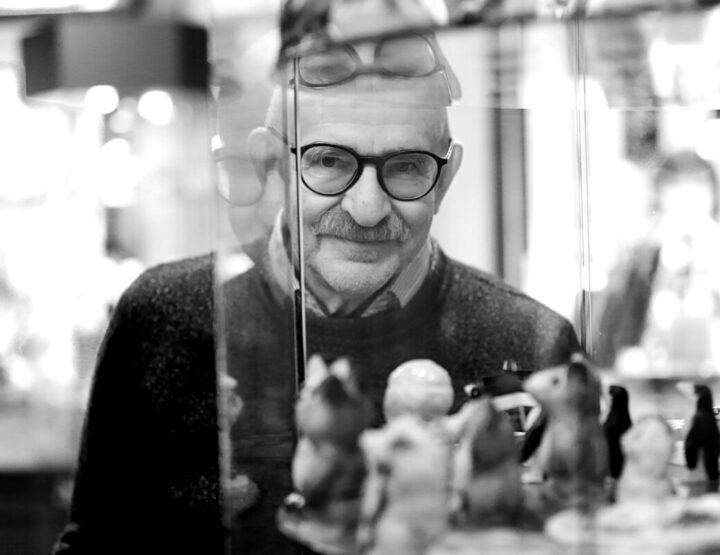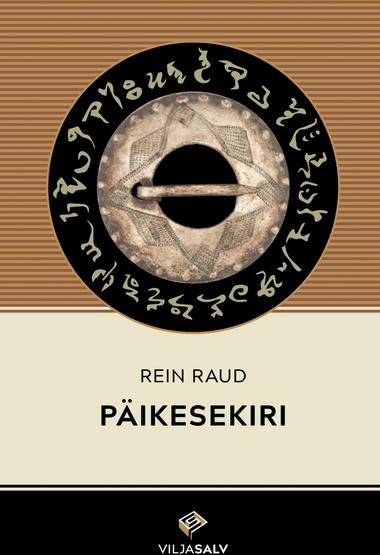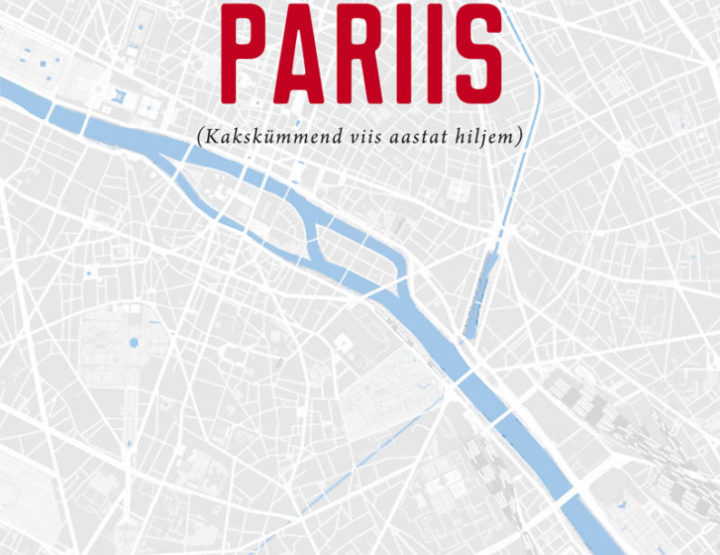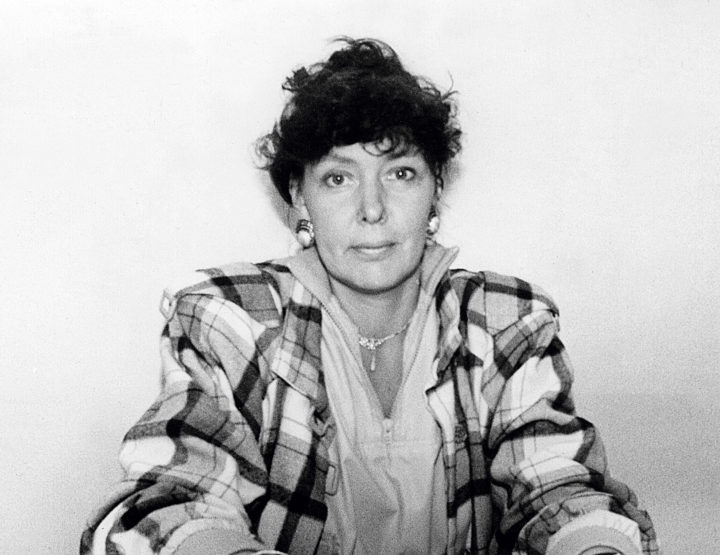Ilona Laaman: Mulle ei meeldinud su nimi (I Did Not Like Your Name)
Huma: Tallinn, 1999. 43 pp
Ilona Laaman (1934) lives in Sweden, where she fled with her mother from the Soviet occupation when she was ten years old. Since 1970 she has published five collections of poetry, short stories and an autobiographical novel Hard Up (Vesi ahjus), where she freely moves between prose text and poetry. All her works are in Estonian. Laaman has retained a sensitive relationship with her homeland and mother tongue, they are the subjects of her original and laconic poetry that is full of paradoxes and wistful irony. Quite often she asks childishly clear why-questions that cancel all explanations. Her poetry has been called aphoristic, existentialist, intense, ironic, self-ironic, etc.
Her sixth collection of poetry I Did Not Like Your Name, published in Tallinn in 1999, contains love poetry. The poetess, who usually avoids the limelight and hides her feelings, does not hide her story this time, but states: ”I fell in love when I was 62 years old. I lived happily with my lover for one year. Then he died suddenly. And I started to write poems again.” The first poem of the collection is short: You marvelled./ – Our honeymoon does still go on/ After six months…/ Why honey? Why moon?/ The end of the honey sea is the beginning of the song. The last line refers to a collection of poetry The End of the Anchor Chain Is the Beginning of the Song (Ankruketi lõpp on laulu algus) by the classic of Estonian surrealist poetry Ilmar Laaban. Ilona Laaman is not exactly a surrealist, but she has always enjoyed deconstructing the language and ordinary ideas. Seeing with a child-like clarity all kinds of unexpected relations, she combines the language and meanings of different levels, achieving the effect of unexpectedness. She asks: How could you, then, suddenly do it this way – / you made up your mind, and died? You had wished only good for me so far.
Laaman’s style and her choice of words is very prose-like, these everyday words are elevated into poetry by a hidden feeling, whose effect is increased by the way it reveals itself. Laaman asks after the death of her lover: Is there really life after death?/ My life/ After your death?, and also states: I cooked my soup/ I will eat it now. (in the poem What Was Waiting For Me In Stockholm; the titles of her poems are usually semantically necessary parts of the unity of the whole poem.) Speaking about the losing of you and the inevitability of the persisting of me, Laaman does not give up the previous motifs of her poems: Some borders/ Are fictitious, optional/ like that between Estonia and Russia/ Whose option? Whose fiction? Non-fictitiously you crossed the border/ between life and death. Behind irony and self-irony the poetry of Ilona Laaman is sensitive, delicate and non-compromising.
Lehte Hainsalu: Viis minutit pärast vihma (Five Minutes After the Rain)
Eesti Raamat: Tallinn, 1999. 128 pp
Kukelokuti (Cock’s Wattle)
Virgela: Tallinn, 1999. 170 pp
Lehte Hainsalu (1938) is the author of numerous books of prose and poetry and children’s books. In 1999 she published two novels: Cock’s Wattle and Five Minutes After the Rain. Cock’s Wattle attracted attention at the novel-writing competition in 1998, Five Minutes … is a direct sequel to a novel Two Minutes Before the Rain, (Kaks minutit enne vihma) published a few years ago.
Five Minutes … is the story about the life and fate of an old woman Juuli, the scene is set in a home of old people. The first part of the novel gives the actual life story of Juuli, in the second part she rather represents the fate of women against the background of the story of a nation, its history. Juuli has already passed away, she is a spiritual being, the spirit of light, but her spiritual eyes see real and historical events. Some facts of Juuli’s life are repeated in both parts of the book (the abortion). This spirit of life speaks a metatext, originating from the Old and New Testament, adding thus value to Juuli’s real life on the earth. The second part of the book attempts at wider generalisations, but after the first part that gives a documented and credible description of a complicated and interesting life of an old woman, it remains rhetorically hollow.
Hainsalu herself calls Cock’s Wattle a novel about a victim. The scene is set at the present time, depicting student life, its subject is the psyche of a girl who has been raped, and her inability to overcome the horror of it. Reti, the main character, repeatedly relives the crime, its memory and temptation haunt her until she is redeemed by final victimisation and final purification. Reti takes refuge in language and tries to purify herself through words, searching for somebody else’s verses for every situation, or using rare words found in the F.J. Wiedemann’s famous Estonian-German dictionary from the 19th century for everyday things. The rapist, whom Reti can call only It, does not represent blind violence. The crime has been amplified by a non-communicative short circuit between two different sign systems, as It interpreted signs and values differently from Reti. Thus Reti is, in her way, a martyr of words, who hides herself in language, being unable to bear reality. She endlessly relives the crime in her memory and fends it off into subconscious with the help of poetry, wishing to ”to go away – into poetry”. The poetry Reti recites is feminine and pure, there are no rough masculine texts. When she cannot escape the reality any more, she backs off into the river, drowning herself. Hainsalu’s intertextual play is probably very difficult to translate, the main idea of the book is interesting, but still a little too mannerist.
Maimu Berg: Ära (Away)
Tuum: Tallinn, 1999. 261 pp
The latest novel of Maimu Berg (1945) is her first great novel. During the previous 12 years Berg has published short stories and short novels, which have found good reception, the most successful among them was I Loved a Russian (Ma armastasin venelast). The title Away is very precise, because going away was one of the mythological dreams during the Soviet time, one of the great narratives of the period. The Soviet press denounced those few outstanding people who had managed to leave the country. After the breakdown of Socialism the myth of escape changed as well.
Away is a love story, just like almost all other Berg’s novels; it tells the love story of a student Tamara and an artist Enn, which took place sometime in the late 1960s. It is also a novel about the betrayal of love, the betrayal of oneself, and about the limits of personality. Enn and Tamara decide to escape from their socialist homeland. The safest way for such an escape is a fictitious marriage. A fictitious husband is found for Tamara, who has to be the first one to leave and wait for Enn, who will also leave using a fictitious marriage. But Tamara cannot wait, the transition from one system into another is too hard for her. As a text, Away is not easy and innocent at all. In Berg’s novels love is in the past and connected with betrayal, it is always over by the moment of narration. Seemingly the traitors are women, but the deep reason for their betrayal is always the weakness of men. The same pattern is found in Away. But the relationship that can be interpreted in several different ways does not make the novel too complex. Away seems to have been written over many earlier texts, it corresponds with Berg’s earlier works, and also with all other works that discuss the so-called problem of eastern Europeans. We could refer to some Estonian works (Viivi Luik’s The Beauty of History, Tõnu Õnnepalu’s Border State), as well as to Milan Kundera’s The Unbearable Lightness of Being.
Away presents such a precise and recognisable image of its period that it can be read with the joy of liberation and even with a trace of nostalgia. Enn wants to get away, because he has recognised his mediocrity and suffers from both the lack of genius and the lack of freedom. The author gives the borders an internal and an external meaning. Also the betrayal of love can be differently interpreted, as Berg herself has pointed out in some interviews. Enn feels that he has betrayed nothing. For Tamara, freedom is everywhere where she can be herself, for Enn, there is no freedom anywhere. There is nowhere to escape, getting away is impossible. Berg leaves her characters in a limbo, she does not believe in happy endings, but still, she is not that cruel as to give up hope.
Ervin Õunapuu: Eesti gootika (Estonian Gothic)
Tallinn: Varrak, 1999. 152 pp
Teie mälestuseks, kes iganes te olete ja kus asute (In Your Memory, Whoever You Are and Wherever You Are)
Tallinn: Umara, 1999. 127 pp
Ervin Õunapuu (1956) is an artist well-known for his theatre scenery and surrealist water-colours. In 1996 he published his first novel Olivias’s Master Class (Olivia meistriklass), which immediately elevated him onto the position of a cult writer for one part of the audience. This way he placed himself right into the centre of Estonian literary scene. The key words, characterising Õunapuu’s work are archetype, myth, absurd and dislocation. He knows how to tell a story, he has a sensitive eye for exact details; light and colours bear an important role in his stories. Generally, his story is a short, striking and dislocated unity. In the collection Estonian Gothic, short stories are divided into three cycles, each containing eight stories. The book opens with the title story Estonian Gothic, which does not belong to any cycle, but describes the rules of the game. A city is created by imagination, it is drawn, it is some kind of a city (Estonian word for it – mingi – creates an untranslatable word play: it is a girl called Ming, who draws this city with the tip of her braid). By some certain markers, the scene of Õunapuu’s stories could well be laid in Estonia, usually he specifies the location somehow. But the most important parameter is time, time is never specified, because everything is the same; the action that seemingly begins sometime in the past, ends now or in the future. Sometimes time, as well as location, changes man, but both time and location have only external characteristics, such as costumes and customs. Actually, Õunapuu’s man does not really change, he represents certain archetypal qualities and passions.
Kaalu’s mother is an instructor at the local party committee, she rises her son with fanatical strictness, the boy is never allowed to laugh. The son wants to know, whether the man with big moustache in the photo is his father. His mother vows that this is a domestic secret that he will never discover (Domestic Things). Little lame Lilli likes to pretend she is a rat. When she tumbles in front of a car and is run over, it is reported that the car smashed a rat (”Little Lilli from Noarootsi”). A boy Eesav, who had been raised by believers of some strange faith, sets himself on fire to get more light (”Golf”). A father sends his son to fetch bread from a hot oven, other children are singing Christmas carols at the same time (”A Good Child”). These are very intense stories that start like a fairy-tale about Hanshen and Gretchen in a realistically precise and brightly marked village milieu, but soon the characters break the rules, and grotesque evil that had already been waiting for its prey, intervenes. Nobody saves Hanshen or Gretchen. The pattern repeats itself: some character is always driven to do more than he is capable of, until he breaks. The milieu etches itself into the reader’s memory, resembling the paintings of Pieter Brueghel or Hieronymus Bosch. And he has to guess, who is the driver and who is the driven one.
Õunapuu’s novels are composed of sequences of pictures. Olivia from the first novel travelled in the time and experienced different possibilities of living. The pictures from the first novel were intriguing and it was quite easy to interpret them. In Your Memory … also presents a vivid chain of pictures, but the interpretation remains questionable. Critics have confessed that they do not understand the novel, they are not sure, whether there is any idea in it at all. Surrealist Õunapuu loves mysticism and passion, his romantic stereotypes usually turn into grotesque. A mining engineer Keller, the central character of In Your Memory …, writes down things that a mysterious somebody, who guides his hand, dictates him. This cryptic novel contains a number of stories, which are (or maybe, are not) intricately interrelated. Keller writes that his task is to write everything down, he has to search for relations. One possibility of relating things could be indicated by a picture of Sankt-Gotthard, which has been placed on the last page of the book. The author lets us glimpse the grandiosity of one possible way of interpretation, another ascent to The Magic Mountain. But even more he invites us to enjoy the beauty of the game.
Kaur Kender: Yuppiejumal (Yuppie God)
Tallinn: Täht, 1999 120 pp
Yuppie God is the second novel of a young author, who made a vigorous breakthrough with his first book ”Iseseivuspäev” (The Day of Independence) in 1998. When The Day of Independence was seen as a reflection of the hell of the postmarxist society, Yuppie God shows us an attempt of creating a new, perfect world, depicted in an ironic and warning key.
Kender, who has studied semiotics, who has owned an advertising agency and who has worked as a copywriter, uses his knowledge and experience about the modern consumer-oriented world. The fundamental text of this book is the First Book of Moses, Genesis; the scene of the novel is laid in advertising industry. The names of the characters and the plot can easily be recognised: at the advertising agency (=Garden of Paradise) that Jaffa (=Yahveh) had established within six days work Mada (=Adam), Eva and Siffer (=Lucifer), whom Jaffa fires soon and who creates a competing agency of his own. Later Mada and Eva are also fired as a result of Siffer’s intrigues, both of them are innocent and naïve. The events of the book have been described through different viewpoints; although the novel is short, Kender has given each of his characters a shrewd individuality.
Through the myth-like structure of Yuppie God, set in modern context, Kender has shown the process of the creation of a new world and a corresponding ”perfect” man – the goal of the advertising industry. One of the problems facing the characters is: ”How should we advertise washing powder to a man who has stood alone on the top of a snowy mountain and listened to silence?” Their aim is to create an advertisement that would totally influence all people, to put it up in neon lettering all over the town so that everybody would follow it. An example of a victim of such brainwashing is a grandmother, who had, under the influence of an ad, written by her grandchild, bought five packages of Windows software, although she had nothing to do with it, she did not even own a computer.
On one hand, Yuppie God is a kind of a modern ”industrial novel”, discussing allegorically the hidden background of advertising industry, on the other hand, it points out the stupefying tendencies that radiate from the mass media, which is a means of reshaping the modern world. The mythical texture and dynamics do not allow us to take this novel as a pure realism, rather it is a dystopian fairy-tale, which also contains several funny subthemes – the Pet Shop Boys’ tour in Tallinn, ironic discussions about the chewing gum, etc. But after reading this beautiful book with golden covers, one does not remember the neon advertisement slogans, but the worry about simple and stupid mass that is so easy to manipulate.
Hiram: Mõru maik (Bitter Taste)
Tallinn: Tuum, 1999. 397 pp
Looks of the 22-year-old student of art, who hides her real name behind the pseudonym Hiram, remind me of Shirley Manson from the band ”Garbage”. This impression is further amplified by the ”soundtrack” of Bitter Taste – all the time people listen to the music, make music and videoclips, they talk about bands, cite songs and films. The novel takes us to the music industry of some unspecified European country and, skating on the glamorous surface, depicts the creators of popular culture still with quite credible realism and detail.
The first person main character is a young professional model and actress Alexandra Ashley, who is an expert in poetry, pop music, cosmetics and clothes, and who mostly fills her days with working out and pampering her body, with acting in advertisement clips and music videos, and furthers her career to professional stage, where she is cast as Ophelia. She is at home in the subculture of musicians and soft drugs, she is a typical representative if i-generation: individualist, intellectual, cosmopolitan and ironical.
The beginning of the novel is quite static, but the tempo accelerates gradually. In the first half of the book we learn in detail about Alex’s habits and life-style, filled with craving for glamour, about parties and bisexual relationships. At the same time the novel almost lacks erotic scenes of any kind. Intrigue develops between Alex’s lesbian girlfriend and her boyfriend Carl, and Carl’s brother Cal, who is a heroin addict. Alex is also haunted by shadows from her recent past: she has had a lesbian relationship with her trainer, the son of the trainer had raped her. A car crash occurring in the middle of the book, which kills a member of the band, initiates the dynamics and disaster that finally motivates Alex’s depression. Further on, Alex’s triumphs and tragedies come in pairs: she identifies with Ophelia, adopts her fears and tries to play absent-mindedness, alternative clarity and distraction, and co-ordination disorders, thus losing her own identity. We could say that Alex fulfils the wish she had expressed at the beginning of the book: ”I want to change my identities in unreal worlds without being punished for it, I long to operate in a flexible space-time, where I could correct my mistakes and where there are dress rehearsals before real events. Do I feel this way because I cannot cope with the reality?” Her ”alter ego” – Ophelia – uses up all her energy and Ophelia’s breakdown on the stage marks also Alex’s own breakdown, although the audience perceives her personal tragedy and sickness on stage, where she vomits blood, as a culmination and triumph of the play. Alex’s tragedy is still further amplified by Cal’s death, the reason of which – an overdose or violence – remains hazy. Cal’s wife had staged his death in a way that cast some shadow of suspicion on Alex.
Bitter Taste was a surprising find at the novel-writing competition in 1998, it was awarded the third prize, and much discussion among the critics. Hiram herself says that her book is about ”the fear of the future of oneself and the world, about not knowing what to do with oneself, and about not being able to accept this situation.” With all its lesbian and drug scenes and exact descriptions of the effect of amphetamine Bitter Taste is a novel about gradual satiety, total overload leading to disaster, existential anxiety of loneliness and paranoia in the modern world on the background of pop culture.
Paul-Eerik Rummo: Luuletused (Poems)
Tallinn: Kupar, 1999. 315 pp
The 1960s were a time of quickening in Estonian literature. The whole generation of young authors, who had been born during WW II or immediately after it, published their first works. This generation is still shaping the face of Estonian literature. The best-known and most translated among these authors are Viivi Luik and Jaan Kaplinski, who both began their careers as poets and who now write mostly prose and journalistic essays.
Of this generation, Paul-Eerik Rummo (1942) has remained true to poetry and has become a living classic. His most productive period was in the 1960s, later he could not publish his poetry and plays because of the censorship. In the 1990s Rummo has been a politician, a member of the parliament and the Minister of Culture. He has translated many authors into Estonian: A. Pushkin, J. Donne, Dylan Thomas, R.D. Laing, last year he published the translation of T.S. Eliot’s The Waste Land.
Rummo’s poetry has reflected the level of hope and openness of the society from the political thaw of the Khrushchev period to the events in Prague in spring 1968 and the following stagnation. His first collection of poetry ”Ankruhiivaja” (Anchor Heaver) (1962) was full of optimism and the discovering of world through a child’s eyes, but during the following decade optimism was replaced by pessimism and the displaying of dissonances. Rummo as a poet has been from the beginning seen as playing the role of Hamlet, at the beginning stressing the affirmative polarity (”Yes, to be, to be, unconditionally, to be”), which was by the end of the 1960s replaced by resignation (”flows into, ah, dies away this élan in a closed preservative”) in an increasingly concentrated expression (”Why I do not kill myself. I don’t want to.”) Into Rummo’s poetry of the 1960s was coded the national identity of the Estonians, the joy and pain of keeping together, carried by noble pathos, recognisable national motifs and musicality. From the turn of the 1960s and 1970s his poetry is more concerned with language experiments and silence, it becomes more passive and distant. The main theme of pointedly commonplace and de-aesthetising poems is coexistence with inevitable. A collection of such poems ”Saatja aadress ja teised luuletused 1968-1972” (A Sender’s Address And Other Poems 1968-1972), composed as an entity, could appear in full only in 1989. It is characteristic that the table of contents of this book gives a title ”Valge leht” (”A White Page”), which marks the poems that could not appear and which were, maybe, destroyed – banned words that were kept from the book.
Poems is a representative selection of Rummo’s whole work, which he has compiled as an interrelated unity. The poet says that ”All poems are the shadows of one and the same that cannot be put into words,” this allows him to play with his texts and offer his readers the joy of recognition as well as new discoveries.
Kalju Kruusa: Meeleolu (Mood)
Erakkond: Tsitre, 1999. 79 pp
In 1999, Kalju Kruusa’s book Mood was awarded the Betti Alver Literary Prize for best debut of the year. The young author (born 1973), quite unknown to the wider audience, has studied English language and literature and semiotics at the University of Tartu, and he belongs to a loose circle of friends called Erakkond, the members of which are all young authors of poetry and prose.
About a dozen of more than fifty texts of this poetry collection are translations: Kruusa has translated Umberto Saba’s poetry from Italian into Estonian, and poems of his friends into English and Finnish. To some extent this fact refers to a game among friends and a reciprocal influence of their works on each other, but it still displays a kind of unity, where the personality of the author can clearly be perceived. At first we notice the author’s strange spelling, avoiding the norms of orthography: he uses “y” instead of “õ”, shows crossed-out words in the text, etc. But the texts themselves originate from an image of the landscape or an experience of everyday life, recording the value and meaning of brief moments of time.
Kruusa acts as a medium, he lets the world flow through himself in such a way that the seemingly unrestricted flow of consciousness creates a chain of images, moments and moods. These images remind us of a Japanese engraving, or a haiku referring to the seasons of the year, permeated by the quiet flow of time. Sometimes his poetry seems to fix things like a camera, but clearly distinguishable discreet commentaries of the author are added to these things. The dominating element of Kruusa’s poetry is chance, occasion: The occasions gather themselves into a collection, as the poet says. Things can be occasional to such extent that a poem, which formally resembles a sonnet, needs a commentary, stating that this resemblance is really purely occasional. Thus, all that we can see on the surface of things is only apparent, and probably occasional.
But the fact that Kruusa writes, and that he writes good poetry, seems to be quite inevitable.
Ilmar Talve: Kevad Eestis (Spring in Estonia)
Tartu: Ilmamaa, 1997. 391 pp
Kutsumata külaline (An Uninvited Guest)
Tartu: Ilmamaa, 1998. 301 pp
Kolmas kodumaa (The Third Homeland)
Tartu: Ilmamaa, 1999. 383 pp
Ilmar Talve (1919), an internationally renowned ethnologist and an honorary member of scientific organisations of several countries has regarded his literary work as a sideline. But all his non-scientific works have nevertheless become various landmarks in Estonian literature. His first book, a collection of short stories Merely A Human Being (Ainult inimene) (1948) gives the Estonian version of the ”lost generation”, his allegoric A House in the Snow (Maja lumes, 1952) has been appreciated as the best Estonian political novel. This novel follows the moods of the inhabitants of one house in a small state located between Slavonia and Teutonia on the eve of WW II. Juhanson’s Travels (Juhansoni reisid, 1959) can be compared with J. Hašek’s The Good Soldier Schweik, its uniqueness lies in humorous depiction of the tragic war events. His essayistic novel Exile (Maapagu, 1988) draws parallels between two periods of exile in the history of the Estonians, depicting the wanderings of a humanist of the early 20th century in Europe on one plane, and reflecting the author’s own experience of exile on the other plane.
Talve’s autobiography of three volumes, which recently won the annual award of the Estonian Cultural Endowment, is a work of precise details and interesting contents, where the writer and the ethnologist in one person has found the best way of expressing his ideas. The first volume, Spring in Estonia, tells about the development of the author, about his lineage and about the milieu of his former home town Tapa. The second half of the book lays the stress on events: the defence of his Master’s thesis in Tartu during the German occupation in 1942; his war experience in Finland; return to Estonia and escape to Germany, and his survival of the perishing of the Nordsten, the ship that was hit by a torpedo on the Baltic Sea; life at a refugee camp in Flensburg, Germany, and, finally, his illegal trip to Sweden via Denmark.
The second volume of the autobiography An Uninvited Guest begins in Germany, suffering the agony of the autumn of 1944, and moves on until Talve’s settling in Turku, Finland, in 1959, which became his third homeland. Between these dates – an insecure time for a refugee – there are the adaptation to the new situation in another country and Talve’s establishing himself as a competent ethnologist. The last volume, The Third Homeland, depicts Talve’s scientific work (by that time he had become a professor at Turku University), the tragedy of his personal life, his travels and the background of his literary work. The chapter discussing the so-called Finlandisation gives an interesting account of the politics of his new homeland and its relations with its large unpredictable neighbour – Russia. The final part of the book tells about the regaining of independence of Estonia in 1991. An index of personal names for all three volumes is added to this book.
Talve’s autobiography is the author’s own story, but it outlines the cultural development and historical fate of the whole of his generation against the background of WW II. The motto of the work – a thought borrowed from Klaus Mann, stating that each human life is unique, and we have to see the drama of the whole generation, the whole nation and the whole era in every single destiny – also indicates such generalisation. On the other hand, the life of a serious scientist could be shaped into a real picaresque novel: the main character is recruited into five different armies, he very ingeniously gets out of all difficult situations, crosses illegally the Danish border to escape from the ruined Germany, and even now his passport gives a wrong location for his birth place.
Ilmar Talve is one of the greatest humanists and existentialists in Estonian literature, his views have been shaped by Albert Camus’ works and the tragic events of his own life and of the life of his people. Frequent images referring to existentialism in his works state the necessity of living and fighting even if everything seems to be hopeless. Belief in humanness, in European humanism and in the persistence of democratic ideas are the permeating themes of the autobiography. The work is centred around a personality, the precondition of its development is a free and democratic state. Talve’s autobiography describes how the lost generation escaped dead end situations and moved forward in spite of the grey horizon surrounding them.
Short outlines of books by Estonian authors
By Rutt Hinrikus
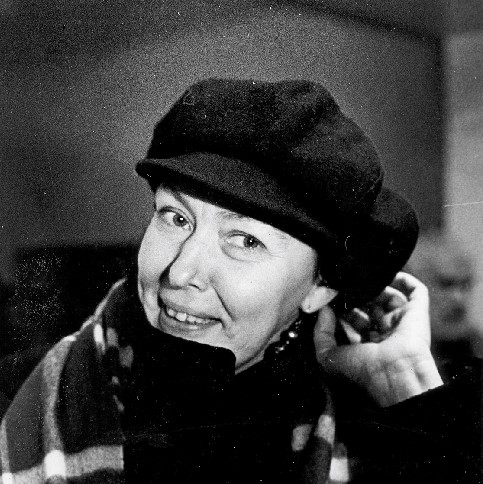
Maimu Berg –
Share:

